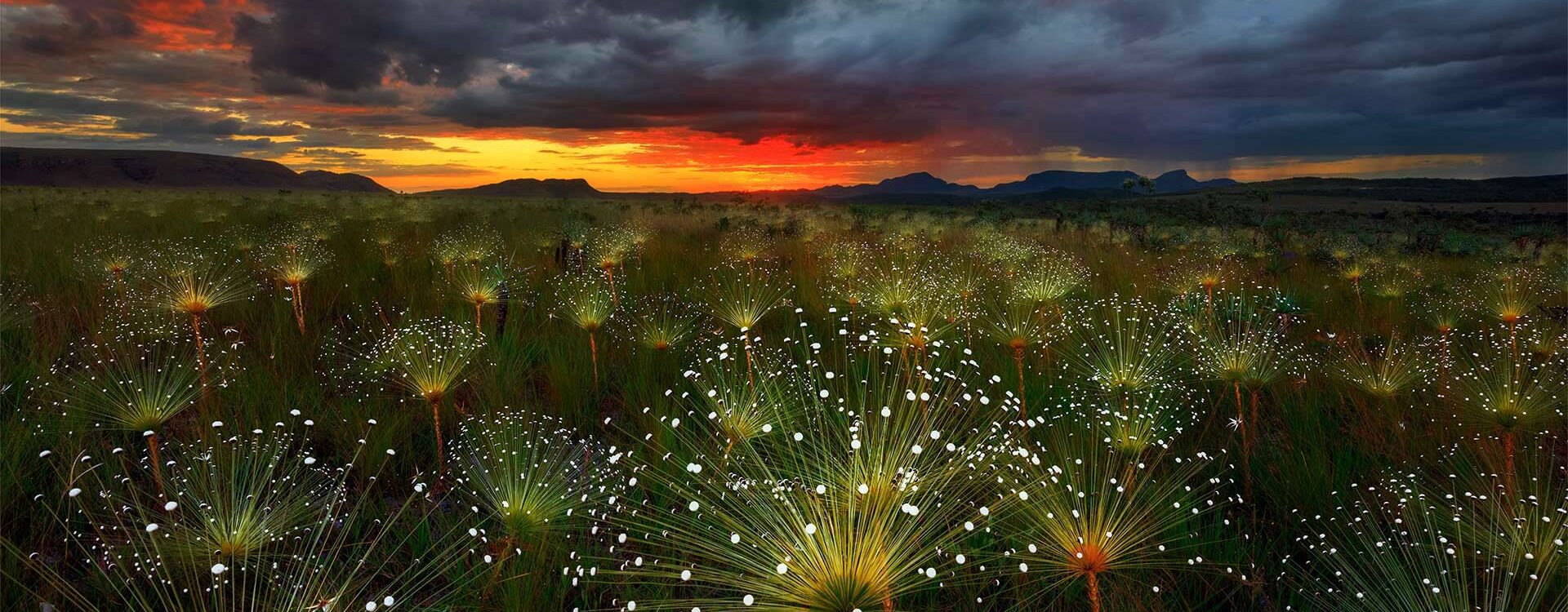Brazil is a country with an extraordinary natural wealth, with stunning landscapes and unique ecosystems in the world. To preserve these natural beauties, the established a series of natural monuments, protected areas that are considered natural heritage of humanity.
The official natural monuments of Brazil are protected areas of exceptional importance, which have unique, unusual or rare natural features, which are considered to be of great scientific, cultural, educational or recreational value. These are places created and supervised by government agencies responsible for environmental conservation, such as the Chico Mendes Institute for Biodiversity Conservation (ICMBio – original acronym in Portuguese) and the Brazilian Institute of the Environment and Renewable Natural Resources (IBAMA – original acronym in Portuguese) .
Among the official natural monuments in Brazil, some areas stand out with impressive singularities, such as:
Chapada dos Veadeiros National Park, in Goiás:

Located in Goiás, the Chapada dos Veadeiros National Park is one of the most important protected areas in the country, highlighting its diversity of Cerrado flora. The park is home to endemic species and several important river sources for the region. The Chapada dos Veadeiros National Park is an important refuge for several species of endangered animals, such as the jaguar, the giant anteater, the maned wolf, the pampas deer and the Brazilian Merganser. In addition, the plateau is home to species of flora endemic to the Cerrado, such as the evergreen, the peroba-rosa and the ipê-roxo, which are important for maintaining the region's ecological balance.
Fernando de Noronha National Park, in Pernambuco:

The Fernando de Noronha National Park is one of the most coveted tourist destinations in Brazil. Located in Pernambuco, the park is known for its beaches with crystalline waters, coral reefs and its rich marine life, home to several species of endangered marine animals, such as the green sea turtle, the nurse shark and the spinner dolphin. . The preservation of the park also helps to protect the breeding and feeding areas of migratory birds, such as the brown booby and the frigatebird.
Fossilized Trees Natural Monument, in Tocantins:

The Fossilized Trees Natural Monument, located in Tocantins, is a paleontological site dating back over 270 million years, where it is possible to find petrified tree trunks and other fossils of prehistoric animals. Among the most outstanding fossils of the monument are the species of trees with arborescences. The Natural Monument of Fossilized Trees, in Tocantins, is home to species of Cerrado vegetation, such as copaíba, jatobá and buriti, which are important for the maintenance of the region's ecosystem. In addition, the preservation of the monument helps to protect fossils of prehistoric animals, such as dinosaurs and pterosaurs.
Morro do Campestre Natural Monument, in Santa Catarina:

The Natural Monument of Morro do Campestre, in Santa Catarina, is a protected area that houses an important archaeological site with rock paintings dating back over 4,000 years. The area is an important record of the culture and history of the people who inhabited the region millennia ago and is home to species of cerrado vegetation, such as pau-terra and mastic. The area is also important for the preservation of animals such as the ocelot, the lesser anteater and the small wild cat, all of which are threatened with extinction.
Natural Monument of Pedra do Baú, in São Paulo:

The Natural Monument of Pedra do Baú, in São Paulo, is another protected area of great importance, which houses impressive rock formations and an ecosystem of the Atlantic Forest that serves as a refuge for several species of animals and plants threatened with extinction, such as the bromeliad, the orchid and the juçara palm heart, which are threatened with extinction. The area is also important for the preservation of animals such as the southern muriqui, the puma and the green-billed toucan, all of which are threatened with extinction. The area is popular with adventure sports such as climbing and abseiling.
The importance of official natural monuments in Brazil goes beyond their scenic beauty and geological uniqueness. These areas are essential for the preservation of biodiversity and ecosystems, helping to maintain the ecological balance and ensure the continuity of plant and animal species that inhabit these regions. In addition, natural monuments have great educational and scientific value, being used for studies and research on the flora, fauna, geology and paleontology of the country.
Preservation and Ecological Tourism
Public visitation is an activity permitted in some protected areas, such as natural monuments, as long as it is carried out in a responsible and sustainable manner, respecting the conservation and preservation rules of these places. Public visitation is important to promote awareness about the importance of environmental conservation and to generate income for local communities through ecological tourism.
However, it is essential that public visitation be carried out in a controlled and sustainable manner, with the aim of minimizing negative impacts on the environment and local fauna. For this, it is important that clear rules are established for public visitation, such as limiting the number of visitors, defining trails and visitation itineraries, and making visitors aware of the importance of environmental preservation.
To preserve these areas of exceptional value, Brazil has several laws and norms that regulate the creation, management and protection of natural monuments, such as Law No. da Natureza (SNUC – original acronym in Portuguese). The law defines the types of conservation units and the criteria for their creation, in addition to establishing the norms for the management, monitoring and inspection of these areas.
In addition to the SNUC Law, other laws and regulations regulate environmental protection in Brazil, such as the Fauna Protection Law (Law No. 5197/1967), the Flora Protection Law (Law No. 4771/1965) and the Crimes Law Environmental (Law No. 9.605/1998). All of this legislation aims to guarantee the protection and conservation of nature and Brazilian biodiversity, including natural monuments.
NGOs (Non-Governmental Organizations) also work to preserve Brazil's natural monuments, as well as other protected areas and the environment in general. These organizations are important in mobilizing society and implementing projects and initiatives for nature conservation and protection.
Some of the best-known NGOs working in environmental preservation in Brazil include the World Wildlife Fund Brazil (WWF), The Nature Conservancy, Instituto Socioambiental, Instituto Chico Mendes de Conservação da Biodiversidade, SOS Mata Atlântica, among others. others. These organizations work in partnership with government authorities, the private sector and the local population to ensure the protection and conservation of natural monuments and other important areas for Brazilian biodiversity.
Preserving Brazil's official natural monuments is essential for the country's biodiversity and ecosystems, in addition to adding great cultural, educational and scientific importance for present and future generations.




